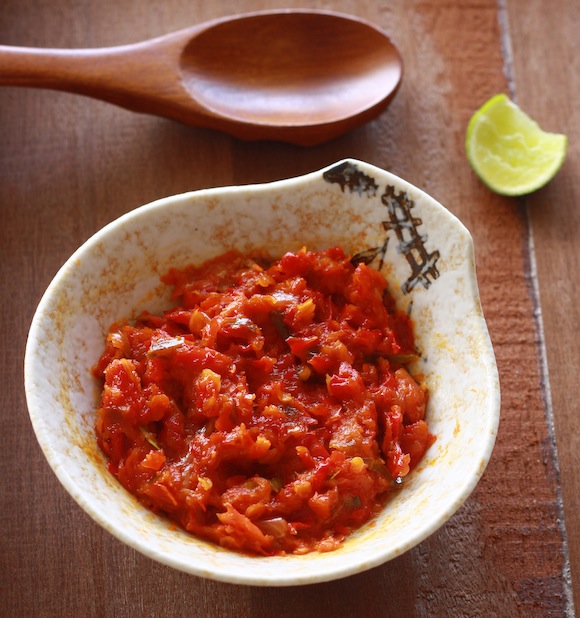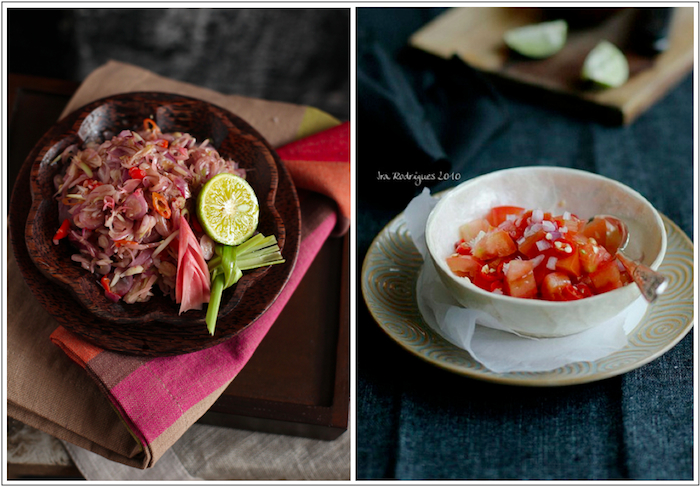Southeast Asians can’t live without chili peppers.
So it is unfathomable to imagine Southeast Asian cuisine before the 16th century when the chili pepper did not exist outside its native place in the Americas. Most dishes in Asia at that time were probably spiced up with black & white pepper.
But 500 years ago, when that first chili hit the shores of the Malay Peninsula and Archipelago (now Malaysia & Indonesia), it was thrown in every local dish and stayed there to this day.
It didn’t take long for Malaysians and Indonesians to realize that they could eat even more of the spice if they pulverized the chili pepper into a paste.
Sambal was born.

Sambal is basically a chili-based condiment or cooking ingredient. But to limit it to a definition would not do it justice. Throughout the diverse region, there are endless varieties of sambal, with pounded chilies mixed with any combination of spices and flavors.
Some sambal can be fire on your tongue, lessening the importance of any additional ingredients. However, most sambals are moderately spicy, allowing the mix of flavors to interact and complement the dish it is served with, like many legendary dishes in the region, such as sambal stuffed fish, sambal ikan bilis (anchovies), sambal prawns, sambal asparagus, sambal kangkong, sambal sotong (squid), sambal telur (eggs), sambal petai (stinky beans).
Sambal is also served as a dip for sweet potato chips, prawn crackers or raw vegetables.
Sambal is also served as a dip for sweet potato chips, prawn crackers or raw vegetables.
Traditional sambal is called sambal oelek – a simple mix of fresh, plump, long red chilies with salt and lime. But for most, sambal oelek is just the starting point. For more depth, think about adding in other spices and ingredients like shallots, garlic, tamarind, belacan (fermented shrimp paste), lemongrass, dried shrimps, ginger, kaffir lime leaves, coconut, peanuts, and galangal.
There is no wrong answer with sambal. Just pick a chili, throw in a few of your favorite ingredients, grind it all up into a paste, and enjoy!
Ready to explore the world of sambal? We’ve handpicked some amazing sambal recipes for you to try out.
{Left} Sambal Matah by Ira of Cooking Tackle – A beautifully presented Balinese sambal with shallots, lemongrass, and the wonderfully fragrant torch ginger flower.
{Right} Sambal Dabu-Dabu by Ira of Cooking Tackle – A simple sambal from the Manado region of North Sulawesi. An Indonesian chunky salsa with chopped tomatoes, shallots, and chili, and a squeeze of lime.
{Left} Sambal Bajak by Pepy of Indonesia Eats - A Javanese sambal that complements all those delicious fried foods in Indonesia. Pepy modified the preparation by first roasting the ingredients, then grinding them, and finally, frying the sambal.
{Right} Sambal Tumpang (Javanese Old Tempe Sambal) by Pepy of Indonesia Eats – Tempe is a soybean cake common in Indonesian dishes, and adds a bit of protein into this unique sambal.
If you’re up for more sambal, do head over to Indonesia Eats where Pepy indulges your need for chili with her extensive recipes for sambal. Some of our favorites include Sambal Andaliman, Sambal Kemiri (candlenut), Sambal Pencok (Sambal terasi with Long Green Beans) and Sambal Tomat (tomato).
{Left} Sambal Belacan by Season with Spice –The spicy glue that holds Malaysia together. This most famous of sambals gets its pungent kick from the belacan - a dried fermented shrimp paste that will stink up any kitchen. Sambal belacan is best with ‘Nasi Lemak’ - Malaysia's iconic dish.
{Right} Sambal belacan with dried shrimps by Anthony of Food Affair Vietnam - Similar to sambal belacan, but this version has the addition of dried shrimps for a more intense taste and aroma.
Still up for one last sambal (pictured first on this article)? This recipe is moderately spicy and is perfect as a chip dip.
Sambal Dip Recipe by Season with Spice
Makes about 1 cup
6 fresh, long red chilies (serrano chilies) - sliced
5 cloves garlic - peeled and chopped
4 shallots - sliced
1 tsp of grated fresh ginger
1 stalk lemongrass - thinly sliced (white part only)
6 kaffir lime leaves - center spine removed, thinly sliced,
3/4 tbsp of Season with Spice's Coconut Palm Sugar
1 tsp salt or to taste
2 tbsp of lime juice
2 tbsp peanut oil
Method:
1. Pound or blend the chilies, garlic, shallots, ginger, kaffir lime leaves, and lemongrass, into a paste.
2. Heat oil in a saucepan over medium-high heat. Saute the paste.
3. Reduce the heat and simmer for 3 minutes. Add sugar and salt. Stir it frequently until the mixture changes color and becomes very fragrant.
4. Remove from heat and leave to cool. Before serving, add lime juice. Serve with chips or crunchy vegetables.
Notes:
1. I used a mortar and pestle to pound the ingredients, so slicing them into smaller piece will help speed up the pounding process.
2. De-seed the chilies if you prefer a milder taste.
3. If you use a food processor to blend the ingredients, add a little water and oil if needed.
4. Store the leftover sambal in an airtight container in the refrigerator for up to a week (or in the freezer longer).
Makes about 1 cup
6 fresh, long red chilies (serrano chilies) - sliced
5 cloves garlic - peeled and chopped
4 shallots - sliced
1 tsp of grated fresh ginger
1 stalk lemongrass - thinly sliced (white part only)
6 kaffir lime leaves - center spine removed, thinly sliced,
3/4 tbsp of Season with Spice's Coconut Palm Sugar
1 tsp salt or to taste
2 tbsp of lime juice
2 tbsp peanut oil
Method:
1. Pound or blend the chilies, garlic, shallots, ginger, kaffir lime leaves, and lemongrass, into a paste.
2. Heat oil in a saucepan over medium-high heat. Saute the paste.
3. Reduce the heat and simmer for 3 minutes. Add sugar and salt. Stir it frequently until the mixture changes color and becomes very fragrant.
4. Remove from heat and leave to cool. Before serving, add lime juice. Serve with chips or crunchy vegetables.
Notes:
1. I used a mortar and pestle to pound the ingredients, so slicing them into smaller piece will help speed up the pounding process.
2. De-seed the chilies if you prefer a milder taste.
3. If you use a food processor to blend the ingredients, add a little water and oil if needed.
4. Store the leftover sambal in an airtight container in the refrigerator for up to a week (or in the freezer longer).









